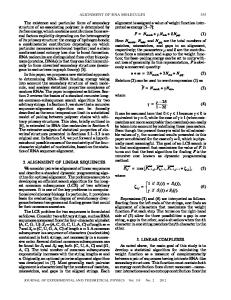Energy Level Alignment and Exciton Binding Energies Using Model Interfaces between Metals and Evaporable Organic Electro
- PDF / 104,708 Bytes
- 6 Pages / 612 x 792 pts (letter) Page_size
- 81 Downloads / 341 Views
Energy Level Alignment and Exciton Binding Energies Using Model Interfaces between Metals and Evaporable Organic Electroluminescent Materials Santos F. Alvarado and Walter Rieß IBM Research, Zurich Research Laboratory 8803 Rüschlikon, Switzerland ABSTRACT We report on a scanning probe spectroscopy study of the electronic properties of model organic/metal interfaces. The experiments allow us to determine parameters that are critical in charge carrier injection and transport, as are the energy gap between positive and negative polaronic states and the height of the barrier for charge carrier injection at metal/organic interfaces. In combination with optical absorption measurements, we gauge the exciton binding energy, a parameter determining energy transport and electroluminescence efficiency. The study was performed on thin films of tris(8-hydroxyquinolato)aluminum (Alq3) deposited on clean and LiF-covered Au(111), and on N,N'-di(naphthalen-1-yl)-N,N'-diphenylbenzidine (NPB) on Ni(111) and substrates. INTRODUCTION One of the most important challenges in the field of research in organic electronic devices is the understanding of interfaces. A solid theoretical knowledge of the underlying physics is necessary to control charge carrier injection and transport at interfaces. On the experimental side, it is necessary to identify techniques that are adequate to characterize the relevant properties of interfaces. Substantial work on the characterization of the alignment of the occupied states of organic/metal interfaces has been done by X-ray photoemission spectroscopy [1-6]. Thus far, not much experimental work has been reported on the electronic properties of the empty states of such interfaces. In this report we present measurements of the alignment of the empty as well as of the filled energy levels of organic/metal interfaces. We use a spectroscopy technique based on the scanning tunneling microscope (STM), where injection of charge carriers into the sample is done at constant tunnel current with the STM tip in intimate contact with the organic material [79]. Local variations of the injection barriers for hole and electrons can be detected due to the nanometer-scale resolution inherent in the scanning probe technique. EXPERIMENTAL DETAILS Thin organic films a few nanometers thick were deposited on metal substrates by sublimation under ultrahigh vacuum (UHV) conditions (base pressure in the lower 10–10 mbar range). Thin films of tris(8-hydroquinolato) aluminum (Alq3) were deposited on Au(111) and of N,N'di(naphthalen-1-yl)-N,N'-diphenyl-benzidine (NPB) on Ni(111). Atomically clean crystalline substrates were prepared in situ by Ne-ion bombardment followed by thermal annealing. For the case of Alq3/Au(111), the effect of intercalated LiF layers of thickness in the range of 0 ≤ d ≤ 1.4 nm, is also discussed. The thickness of the thin films was determined by a quartz crystal C5.12.1
microbalance. All STM measurements reported here were done in situ under UHV conditions. The principle of the STM-based spectroscopy techniq
Data Loading...










